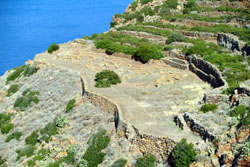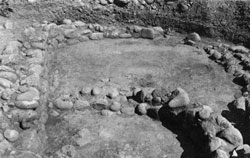
L. Bernaḅ Brea, M. Cavalier - Meligunìs Lipàra VI
Filicudi, Insediamenti dell'età del bronzo. Appendici di R.M. Albanesi Procelli, M.C. Martinelli, L. Vagnetti, P. Villari, J.L. Williams, Palermo 1991.
By c.3000 BC the island of Filicudi must have had a stable population. This is demonstrated by the fragments of Diana style pottery found on the Montagnola di Capo Graziano and along the southern shoreline of the bay of Porto.
At the beginning of the Bronze Age, perhaps even before the third millennium, a large settlement arose on the island. Its inhabitants were undoubtedly newcomers, who had come from afar, and who settled here. We have recognized in them, we believe, the Aeolians of legend, whose name (derived from the Greek demigod of the winds Aeolus) the islands still bear.
This is a large village situated on the southern side of the Piano del Porto covering a longitudinal area of over 900 metres. The greatest density of huts is especially on the plain round the harbour (Piano del Porto).
Very limited excavations have been conducted near Filo di Lorani in the stretch called Filo Braccio.
Two huts have been revealed, the one far larger than the other. They were built with pebbles from the Tyrrhenian beach. The foundations of these huts are laid over the remains of two older huts. The two huts were built beside them and in the interstice between them a group of little vases was found, perhaps a small votive pit.
The trench above the Lopez house revealed a well-preserved oval hut with walls built of pebbles from the fossil beach and clay.
The finding of these huts enables us clearly to define the pottery style of the initial phase of Aeolian culture in the early Bronze Age and to ascertain the resemblance of the ceramic forms to those of the cultures of the same period in continental Greece. They also provide us with a clue about the origin of the people to whom this culture is due.
Several centuries later, more precisely at the beginning of the second millennium BC, the settlement was transferred from the shoreline, impossible to defend, to higher ground: more precisely to the summit of the Montagnola di Capo Graziano overlooking the harbour. This site was a natural fortress, occupying a position that was far more suitable for defence.
The excavations have revealed the foundations of just under thirty huts on this site. They are closely packed together, testifying both to a numerous population and the restriction of the available space. They are oval huts built with local volcanic stone: irregularly fractured latitandesite.
Two periods, stratigraphically quite distinct can be recognized in the excavation of this settlement. The earlier of the two corresponds to the later more highly developed phases of the Capo Graziano culture successive to the transfer of the settlement. Only in the higher levels of the strata referable to the Capo Graziano culture do fragments of imported Aegean pottery begin to appear. These are wares corresponding to a meso-Helladic tradition prolonged in the Mycenaean period (i.e. late Helladic) or proto-Mycenaean painted pottery of styles I and II, which provide us with a very precise dating and enable us to recognize that the Capo Graziano culture continued to evolve right down to transition from Mycenaean style II to III, in other words down to c.1430.
The level of the Capo Graziano culture is superimposed by those of the Milazzese culture, characterized by a wholly different pottery repertoire, Sicilian in origin and type.
In the levels of the first phase of this new culture are also found fragments of imported Aegean pottery, now in the Mycenaean style III A1, dating to the late 15th and early 14th century BC.
The settlement of the Milazzese period, like all the other contemporary settlements in the Aeolian Isles, ended with a violent destruction, datable to the first decades of the 13th century BC.
Part III of the volume describes the burial site in natural ravines on the slopes of Montagnola di Capo Graziano.
They are tombs of artificial rock-cut (groticella or “oven”) type, copying the type of tomb excavated in the rock used in Sicily since Neolithic times. Tombs of this type, used for collective burials, were widespread not only in Sicily but also in the Italian peninsula during the same period.
The hardness of the rock precluded the hewing into it of regular burial chambers, and so attempts were made to adapt as best as possible to the same function whatever nature itself offered that was most similar.
The grave goods consist of little vases; their type shows they belonged to a rather early phase of the Capo Graziano culture.


